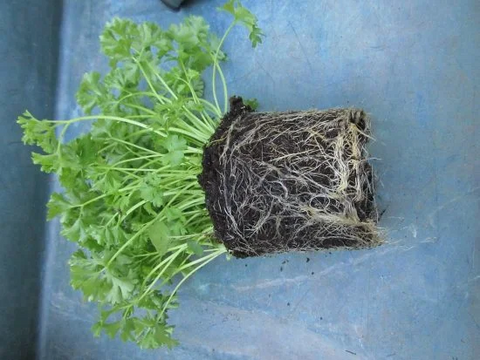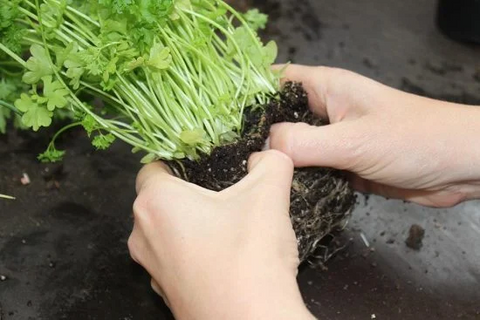Are you an avid gardener looking to make the most out of your parsley plant? Dividing your parsley is a smart choice for several reasons, and it's easier than you might think. Let's explore why you should consider this gardening technique and the steps to do it right.

Why Divide Parsley?
- Cost-Efficient:
Dividing parsley at home is a cost-effective choice. Once you have a thriving parsley plant, you can create multiple new plants without the need to purchase additional seeds or seedlings. This not only saves money but also reduces the number of trips to the gardening store.
- Encourages Healthy Growth:
As parsley plants grow, they can become crowded, competing for nutrients and space. Dividing the plant provides each section with the space it needs to flourish, improving the overall health and yield of the plant.
- Genetic Consistency:
When you divide a parsley plant, the new ones are essentially clones of the original. This means that if you have a particularly flavorful or robust parsley plant, dividing it will produce new plants with the same desirable traits.
- Easy Sharing:
Dividing your parsley makes it easy to share with friends, family, or neighbors. It's a wonderful way to spread the joy of gardening and introduce others to the benefits of growing their own herbs.
- Ideal for Small Spaces:
Not everyone has a vast garden. Dividing parsley plants allows you to maximize your available space. Since parsley can thrive even in small pots, you can enjoy homegrown herbs without requiring a lot of room.
- Enhanced Flavor and Aroma:
Homegrown parsley often boasts a richer flavor and aroma compared to store-bought varieties. By dividing your own plants, you can ensure a consistent supply of high-quality parsley for your culinary adventures.

When to Divide Parsley?
To successfully divide your parsley plants, timing is crucial. Here's how you'll know it's the right time to divide:
Mature Plant: The plant should be well-established, ideally at least one year old, to handle the division process effectively.
Healthy Growth: Look for signs of vitality like lush, green leaves and strong stems. Avoid dividing plants that are diseased or stressed.
Root Structure: Gently unearth a small section of the plant's root system to check its density. A well-developed, thick root system indicates that the plant is ready for division.
Overcrowding: If the plant seems crowded or has reduced yields, it may be competing for resources, suggesting that division may help.
Best Time for Division
For Warm Climates:
Late Winter to Early Spring: Dividing parsley during this period allows the plant to recover before the intense summer heat, providing ample time for establishment.
Early Autumn: This is another suitable time, especially if you missed the spring window. The mild weather allows for easier establishment.
For Cold Climates:
Late Spring to Early Summer: In colder regions, it's advisable to wait until the last frost has passed, allowing new divisions enough time to establish before winter.
Late Summer: If you missed the early summer period, late summer can also work, provided you give the plants enough time to establish before the first frost.
Steps to Divide Parsley
- Preparations
Gather Supplies: You'll need a sharp knife or garden shears, fresh potting soil, pots with drainage holes, and a watering can.
Water the Plant: Water your parsley thoroughly the day before you plan to divide it to reduce stress during the division process.
- Division Process
Remove the Plant: Carefully extract the parsley plant from its current pot or garden spot. Shake off excess soil to expose the root ball.
Inspect the Roots: Look for natural divisions in the root system—these are the points where you'll separate the plant.
Make the Cut: Using a sharp knife or shears, cut through the root ball to create separate divisions. Aim for at least two to three healthy stems per division.
Trim Excess: Remove any dead or overly long roots and trim back any damaged or dead leaves.
- Potting the New Divisions
Prepare the Pots: Fill your new pots halfway with fresh, well-draining potting soil.
Position the Division: Place each division in the center of a new pot.
Add Soil: Fill the pot with more soil, leaving about an inch at the top for watering. Gently press the soil around the base of the plant to secure it.
Water Thoroughly: Immediately water each new division after potting to help it settle and recover from the transplant shock.
Place in Appropriate Light: For the first few days, keep the pots in a location with indirect light to minimize stress, gradually transitioning them to their ideal light conditions.
- Aftercare
Keep Soil Moist: For the first few weeks, keep the soil consistently moist but not waterlogged.
Monitor Health: Keep an eye out for any signs of stress or disease and take appropriate measures if needed.
Dividing parsley is an excellent way to multiply your harvest, share the joy of gardening, and enjoy the fresh, flavorful herbs in your culinary creations.










Comments
Ramón said:
Hola soy de Santiago de Chile y tengo una mata de perejil hace un añito esperaré otro año para la separación.
Gracias.
Felicidades.